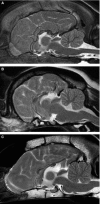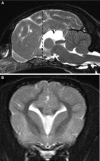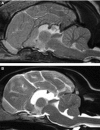Corpus callosal abnormalities in dogs
- PMID: 24839863
- PMCID: PMC4857934
- DOI: 10.1111/jvim.12371
Corpus callosal abnormalities in dogs
Abstract
Background: Corpus callosal abnormalities (CCA) in dogs have been only sporadically reported and are poorly characterized.
Hypothesis/objectives: To describe the clinical presentation and magnetic resonance imaging (MRI) characteristics of dogs with CCA.
Animals: Fifteen client-owned dogs.
Methods: Retrospective study. Records of the contributing institutions were reviewed to identify dogs diagnosed with malformations affecting the corpus callosum (CC); cases in which the CCA was thought to be secondary were excluded.
Results: The most represented breeds were Staffordshire Bull Terriers (5/15) and Miniature Schnauzers (3/15; n = 3, 20%) and the mean age at time of presentation of 19 months (range 3-81 months). The clinical signs most commonly reported were adipsia/hypodipsia with associated hypernatremia (12/15), tremors (6/15), and seizures (6/15). Review of the MR images revealed that 10 dogs had absence of the rostral CC and hypoplasia of the caudal portion, 4 dogs had a diffusely hypoplastic and dysplastic CC, and 1 dog had a diffusely hypoplastic CC. In 14 cases, there was abnormal cortical development with fusion of the ventral frontal lobes and part of the diencephalon, indicating lobar holoprosencephaly.
Conclusions and clinical importance: Previous literature has mainly associated CCA with adipsia and only 12 of 15 dogs in the current series demonstrated this abnormality. There are different degrees of the malformation but in 10 dogs the rostral portion of the CC is most severely affected. Fourteen dogs have simultaneous fusion of the midline structures rostral to the CC; this region has several structures involved in thirst regulation and might explain this derangement.
Keywords: Adipsia; Corpus callosum; Dog; Holoprosencephaly.
Copyright © 2014 by the American College of Veterinary Internal Medicine.
Figures




References
-
- Raybaud C. The corpus callosum, the other great forebrain commissures, and the septum pellucidum: Anatomy, development and malformation. Neuroradiology 2010;52:447–477. - PubMed
-
- Aboitiz F, Montiel J. One hundred million years of interhemispheric communication: The history of the corpus callosum. Braz J Med Biol Res 2003;36:409–420. - PubMed
-
- Jeret JS, Serur D, Wisniewski K, Fisch C. Frequency of agenesis of the corpus callosum in the developmentally disabled population as determined by computerized tomography. Pediatr Neurosci 1985‐1986;12:101–103. - PubMed
-
- Bedeschi MF, Bonaglia MC, Grasso R, et al. Agenesis of the corpus callosum: Clinical and genetic study in 63 young patients. Pediatr Neurol 2006;34:186–193. - PubMed
MeSH terms
LinkOut - more resources
Full Text Sources
Other Literature Sources

